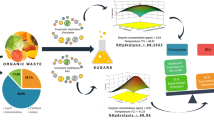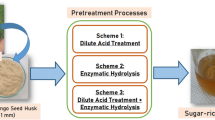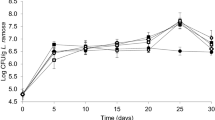Abstract
Agro-industrial wastes could become a source of revenue through their valorization while reducing their management and disposal issues. In this work, residues from the mango industry have been investigated as a source of sugars for the synthesis of 5-hydroxymethylfurfural (HMF), a high value platform chemical. Mangoes, which were past the last stage of ripening, were used as feedstock for microwave-assisted synthesis of HMF under hydrothermal conditions. The product was quantified through HPLC-DAD. The experimental conditions permitted a maximal HMF yield of 21.2 mol% in a 20-min reaction time at 150 °C with a 1:19 dilution ratio. The advantages of the synthesis pathway include the use of microwave heating and water as solvent media, which renders the reaction pathway eco-friendly. High temperatures and prolonged reaction times seem to lead to unidentified side products which lead to a reduction in HMF yield. The results presented in this work highlight mango fruit waste as a potential biomass for HMF production. This would give value to a current agro-industrial waste while attending to current problems linked to its disposal.



Similar content being viewed by others
References
FAO (2019) SAVE FOOD: global initiative on food loss and waste reduction. http://www.fao.org/save-food/resources/keyfindings/en/. Accessed 09-2019 2019
CEC (2017) Characterization and management of food loss and waste in North America. Commission for Environmental Cooperation, Montreal, Canada
Venkata Mohan S, Nikhil GN, Chiranjeevi P, Nagendranatha Reddy C, Rohit MV, Kumar AN, Sarkar O (2016) Waste biorefinery models towards sustainable circular bioeconomy: critical review and future perspectives. Bioresour Technol 215:2–12. https://doi.org/10.1016/j.biortech.2016.03.130
Dahiya S, Kumar AN, Shanthi Sravan J, Chatterjee S, Sarkar O, Mohan SV (2018) Food waste biorefinery: sustainable strategy for circular bioeconomy. Bioresour Technol 248:2–12. https://doi.org/10.1016/j.biortech.2017.07.176
Uçkun Kıran E, Trzcinski AP, Liu Y (2015) Platform chemical production from food wastes using a biorefinery concept. J Chem Technol Biotechnol 90(8):1364–1379. https://doi.org/10.1002/jctb.4551
Menegazzo F, Ghedini E, Signoretto M (2018) 5-Hydroxymethylfurfural (HMF) production from real biomasses. Molecules 23(9):2201
**ong X, Yu IKM, Tsang DCW, Bolan NS, Sik Ok Y, Igalavithana AD, Kirkham MB, Kim K-H, Vikrant K (2019) Value-added chemicals from food supply chain wastes: state-of-the-art review and future prospects. Chem Eng J 375:121983. https://doi.org/10.1016/j.cej.2019.121983
Yu IKM, Ong KL, Tsang DCW, Haque MA, Kwan TH, Chen SS, Uisan K, Kulkarni S, Lin CSK (2018) Chemical transformation of food and beverage waste-derived fructose to hydroxymethylfurfural as a value-added product. Catal Today 314:70–77. https://doi.org/10.1016/j.cattod.2018.01.011
Yu IKM, Tsang DCW, Yip ACK, Chen SS, Wang L, Ok YS, Poon CS (2017) Catalytic valorization of starch-rich food waste into hydroxymethylfurfural (HMF): controlling relative kinetics for high productivity. Bioresour Technol 237:222–230. https://doi.org/10.1016/j.biortech.2017.01.017
Mukherjee A, Dumont M-J, Raghavan V (2015) Review: Sustainable production of hydroxymethylfurfural and levulinic acid: challenges and opportunities. Biomass Bioenergy 72:143–183. https://doi.org/10.1016/j.biombioe.2014.11.007
Van Putten RJ, Van Der Waal JC, De Jong E, Rasrendra CB, Heeres HJ, De Vries JG (2013) Hydroxymethylfurfural, a versatile platform chemical made from renewable resources. Chem Rev 113(3):1499–1597. https://doi.org/10.1021/cr300182k
Torres AI, Daoutidis P, Tsapatsis M (2010) Continuous production of 5-hydroxymethylfurfural from fructose: a design case study. Energy Environ Sci 3(10):1560–1572. https://doi.org/10.1039/C0EE00082E
Kazi FK, Patel AD, Serrano-Ruiz JC, Dumesic JA, Anex RP (2011) Techno-economic analysis of dimethylfuran (DMF) and hydroxymethylfurfural (HMF) production from pure fructose in catalytic processes. Chem Eng J 169(1):329–338. https://doi.org/10.1016/j.cej.2011.03.018
Portillo Perez G, Mukherjee A, Dumont M-J (2019) Insights into HMF catalysis. J Ind Eng Chem 70:1–34. https://doi.org/10.1016/j.jiec.2018.10.002
Wu K, Wu Y, Chen Y, Chen H, Wang J, Yang M (2016) Heterogeneous catalytic conversion of biobased chemicals into liquid fuels in the aqueous phase. ChemSusChem 9(12):1355–1385. https://doi.org/10.1002/cssc.201600013
Zhou P, Zhang Z (2016) One-pot catalytic conversion of carbohydrates into furfural and 5-hydroxymethylfurfural. Cat Sci Technol 6(11):3694–3712. https://doi.org/10.1039/c6cy00384b
Zhao H, Holladay JE, Brown H, Zhang ZC (2007) Metal chlorides in ionic liquid solvents convert sugars to 5-hydroxymethylfurfural. Science 316(5831):1597–1600. https://doi.org/10.1126/science.1141199
Jadhav H, Taarning E, Pedersen CM, Bols M (2012) Conversion of d-glucose into 5-hydroxymethylfurfural (HMF) using zeolite in [Bmim]Cl or tetrabutylammonium chloride (TBAC)/CrCl2. Tetrahedron Lett 53(8):983–985. https://doi.org/10.1016/j.tetlet.2011.12.059
Bicker M, Hirth J, Vogel H (2003) Dehydration of fructose to 5-hydroxymethylfurfural in sub- and supercritical acetone. Green Chem 5(2):280–284. https://doi.org/10.1039/b211468b
Qi X, Watanabe M, Aida TM, Smith RL Jr (2010) Efficient one-pot production of 5-hydroxymethylfurfural from inulin in ionic liquids. Green Chem 12(10):1855–1860. https://doi.org/10.1039/C0GC00141D
Qi X, Watanabe M, Aida TM, Smith JRL (2009) Efficient process for conversion of fructose to 5-hydroxymethylfurfural with ionic liquids. Green Chem 11(9):1327–1331. https://doi.org/10.1039/B905975J
Asghari FS, Yoshida H (2006) Acid-catalyzed production of 5-hydroxymethyl furfural from D-fructose in subcritical water. Ind Eng Chem Res 45(7):2163–2173. https://doi.org/10.1021/ie051088y
Yemiş O, Mazza G (2012) Optimization of furfural and 5-hydroxymethylfurfural production from wheat straw by a microwave-assisted process. Bioresour Technol 109:215–223. https://doi.org/10.1016/j.biortech.2012.01.031
Lucas-Torres C, Lorente A, Cabanas B, Moreno A (2016) Microwave heating for the catalytic conversion of melon rind waste into biofuel precursors. J Clean Prod 138:59–69. https://doi.org/10.1016/j.jclepro.2016.03.122
Iryani DA, Kumagai S, Nonaka M, Sasaki K, Hirajima T (2013) Production of 5-hydroxymethyl furfural from sugarcane bagasse under hot compressed water. Prog Earth Planet Sci 6:441–447. https://doi.org/10.1016/j.proeps.2013.01.058
Yu IKM, Tsang DCW, Yip ACK, Chen SS, Ok YS, Poon CS (2017) Valorization of starchy, cellulosic, and sugary food waste into hydroxymethylfurfural by one-pot catalysis. Chemosphere 184:1099–1107. https://doi.org/10.1016/j.chemosphere.2017.06.095
Brown DW, Floyd AJ, Kinsman RG, Roshanhyphen AY (1982) Dehydration reactions of fructose in non-aqueous media. J Chem Technol Biotechnol 32(7-12):920–924. https://doi.org/10.1002/jctb.5030320730
Roy Goswami S, Mukherjee A, Dumont M-J, Raghavan V (2016) One-pot conversion of corn starch into 5-hydroxymethylfurfural in water-[Bmim]Cl/MIBK Biphasic Media. Energy Fuel 30(10):8349–8356. https://doi.org/10.1021/acs.energyfuels.6b01699
Aristizábal MV, Gómez PÁ, Cardona ACA (2015) Biorefineries based on coffee cut-stems and sugarcane bagasse: furan-based compounds and alkanes as interesting products. Bioresour Technol 196:480–489. https://doi.org/10.1016/j.biortech.2015.07.057
Sınaǧ A, Kruse A, Rathert J (2004) Influence of the heating rate and the type of catalyst on the formation of key intermediates and on the generation of gases during hydropyrolysis of glucose in supercritical water in a batch reactor. Ind Eng Chem Res 43(2):502–508. https://doi.org/10.1021/ie030475+
Watanabe M, Aizawa Y, Iida T, Levy C, Aida TM, Inomata H (2005) Glucose reactions within the heating period and the effect of heating rate on the reactions in hot compressed water. Carbohydr Res 340(12):1931–1939. https://doi.org/10.1016/j.carres.2005.05.019
Qi X, Watanabe M, Aida TM, Smith RL Jr (2008) Catalytical conversion of fructose and glucose into 5-hydroxymethylfurfural in hot compressed water by microwave heating. Catal Commun 9(13):2244–2249. https://doi.org/10.1016/j.catcom.2008.04.025
Hansen TS, Woodley JM, Riisager A (2009) Efficient microwave-assisted synthesis of 5-hydroxymethylfurfural from concentrated aqueous fructose. Carbohydr Res 344(18):2568–2572. https://doi.org/10.1016/j.carres.2009.09.036
Sweygers N, Alewaters N, Dewil R, Appels L (2018) Microwave effects in the dilute acid hydrolysis of cellulose to 5-hydroxymethylfurfural. Sci Rep-Uk 8(1):7719. https://doi.org/10.1038/s41598-018-26107-y
Singh Z, Singh RK, Sane VA, Nath P (2013) Mango - Postharvest biology and biotechnology. Crit Rev Plant Sci 32(4):217–236. https://doi.org/10.1080/07352689.2012.743399
Zafar TA, Sidhu JS (2017) Composition and nutritional properties of mangoes. Handbook of Mango Fruit: Production, Postharvest Science, Processing Technology and Nutrition:217
Lorenzo-Santiago M, Juárez-López A, Rosas-Acevedo J, Rendón-Villalobos J, Toribio-Jiménez J, García-Hernández E (2018) Management and final disposal of mango waste in the State of Guerrero, Mexico: a brief review. J Agric Sci 10(12):34
Saranwong S, Sornsrivichai J, Kawano S (2004) Prediction of ripe-stage eating quality of mango fruit from its harvest quality measured nondestructively by near infrared spectroscopy. Postharvest Biol Technol 31(2):137–145
National Mango Board (2010) Mango maturity and ripeness guide. National Mango Board,. https://www.mango.org/wp-content/uploads/2017/10/Mango_Maturity_And_Ripeness_Guide.pdf. 2020
Ali A, Hei GK, Keat YW (2016) Efficacy of ginger oil and extract combined with gum arabic on anthracnose and quality of papaya fruit during cold storage. J Food Sci Technol 53(3):1435–1444. https://doi.org/10.1007/s13197-015-2124-5
Svenningsen GS, Kumar R, Wyman CE, Christopher P (2018) Unifying mechanistic analysis of factors controlling selectivity in fructose dehydration to 5-hydroxymethylfurfural by homogeneous acid catalysts in aprotic solvents. ACS Catal 8(6):5591–5600. https://doi.org/10.1021/acscatal.8b01197
Shallenberger RS, Mattick LR (1983) Relative stability of glucose and fructose at different acid pH. Food Chem 12(3):159–165. https://doi.org/10.1016/0308-8146(83)90002-X
Salvatierra Virgen S, Ceballos-Magaña SG, Salvatierra-Stamp VC, Sumaya-Martínez MT, Martínez-Martínez FJ, Muñiz-Valencia R (2017) HPLC-DAD method development and validation for the quantification of hydroxymethylfurfural in corn chips by means of response surface optimisation. Food Addit Contam Part A Chem Anal Control Expo Risk Assess 34(12):2101–2110
Castrillo M, Kruger NJ, Whatley FR (1992) Sucrose metabolism in mango fruit during ripening. Plant Sci 84(1):45–51. https://doi.org/10.1016/0168-9452(92)90206-2
Maldonado-Celis ME, Yahia EM, Bedoya R, Landázuri P, Loango N, Aguillón J, Restrepo B, Guerrero Ospina JC (2019) Chemical composition of mango (Mangifera indica L.) fruit: nutritional and phytochemical compounds. Front Plant Sci 10:1073–1073. https://doi.org/10.3389/fpls.2019.01073
Skrede G (1983) Changes in sucrose, fructose and glucose content of frozen strawberries with thawing. J Food Sci 48(4):1094–1096. https://doi.org/10.1111/j.1365-2621.1983.tb09168.x
Torija E, Díez C, Matallana C, Camara M, Camacho E, Mazarío P (1998) Influence of freezing process on free sugars content of papaya and banana fruits. J Sci Food Agric 76(3):315–319. https://doi.org/10.1002/(SICI)1097-0010(199803)76:3<315::AID-JSFA929>3.0.CO;2-7
Weingarten R, Cho J, **ng R, Conner WC, Huber GW (2012) Kinetics and reaction engineering of levulinic acid production from aqueous glucose solutions. ChemSusChem 5(7):1280–1290. https://doi.org/10.1002/cssc.201100717
Qian X (2012) Mechanisms and energetics for Brønsted acid-catalyzed glucose condensation, dehydration and isomerization reactions. Top Catal 55(3):218–226. https://doi.org/10.1007/s11244-012-9790-6
Yang G, Pidko EA, Hensen EJM (2012) Mechanism of Brønsted acid-catalyzed conversion of carbohydrates. J Catal 295:122–132. https://doi.org/10.1016/j.jcat.2012.08.002
Yang L, Tsilomelekis G, Caratzoulas S, Vlachos DG (2015) Mechanism of Brønsted acid-catalyzed glucose dehydration. ChemSusChem 8(8):1334–1341. https://doi.org/10.1002/cssc.201403264
Cantero DA, Bermejo MD, Cocero MJ (2015) Governing chemistry of cellulose hydrolysis in supercritical water. ChemSusChem 8(6):1026–1033. https://doi.org/10.1002/cssc.201403385
Jadhav H, Pedersen CM, Sølling T, Bols M (2011) 3-Deoxy-glucosone is an intermediate in the formation of furfurals from D-glucose. ChemSusChem 4(8):1049–1051. https://doi.org/10.1002/cssc.201100249
Patil SKR, Lund CRF (2011) Formation and growth of humins via aldol addition and condensation during acid-catalyzed conversion of 5-hydroxymethylfurfural. Energy Fuel 25(10):4745–4755. https://doi.org/10.1021/ef2010157
Zhang L, ** G, Zhang J, Yu H, Wang X (2017) Efficient catalytic system for the direct transformation of lignocellulosic biomass to furfural and 5-hydroxymethylfurfural. Bioresour Technol 224:656–661. https://doi.org/10.1016/j.biortech.2016.11.097
Yu IKM, Tsang DCW, Yip ACK, Chen SS, Ok YS, Poon CS (2016) Valorization of food waste into hydroxymethylfurfural: dual role of metal ions in successive conversion steps. Bioresour Technol 219:338–347. https://doi.org/10.1016/j.biortech.2016.08.002
Shao Y, Tsang DCW, Shen D, Zhou Y, ** Z, Zhou D, Lu W, Long Y (2020) Acidic seawater improved 5-hydroxymethylfurfural yield from sugarcane bagasse under microwave hydrothermal liquefaction. Environ Res 184:109340. https://doi.org/10.1016/j.envres.2020.109340
Shao Y, Long Y, Zhou Y, ** Z, Zhou D, Shen D (2019) 5-Hydroxymethylfurfural production from watermelon peel by microwave hydrothermal liquefaction. Energy 174:198–205. https://doi.org/10.1016/j.energy.2019.02.181
Hoşgün EZ (2020) One-pot hydrothermal conversion of poppy stalks over metal chloride catalysts. Biomass Conv Bioref. https://doi.org/10.1007/s13399-020-00682-5
Eriksson M, Strid I, Hansson P-A (2015) Carbon footprint of food waste management options in the waste hierarchy – a Swedish case study. J Clean Prod 93:115–125. https://doi.org/10.1016/j.jclepro.2015.01.026
Cai CM, Nagane N, Kumar R, Wyman CE (2014) Coupling metal halides with a co-solvent to produce furfural and 5-HMF at high yields directly from lignocellulosic biomass as an integrated biofuels strategy. Green Chem 16(8):3819–3829. https://doi.org/10.1039/C4GC00747F
Yang Y, Hu C-w, Abu-Omar MM (2012) Conversion of carbohydrates and lignocellulosic biomass into 5-hydroxymethylfurfural using AlCl3·6H2O catalyst in a biphasic solvent system. Green Chem 14(2):509–513. https://doi.org/10.1039/C1GC15972K
Tian X, Qi B, Zhang S, Luo J, Wan Y (2020) Catalytic production of 5-hydroxymethylfurfural from sucrose and molasses by aluminum chloride in green aqueous γ-valerolactone system. Biomass Conv Bioref. https://doi.org/10.1007/s13399-020-00603-6
Funding
This work was funded by the Secretaría de Educación Pública through the “Apoyo a la incorporación de NPTC” UCOL-PTC-271 grant.
Author information
Authors and Affiliations
Corresponding author
Ethics declarations
Conflict of interest
The authors declare that they have no conflict of interest.
Additional information
Publisher’s Note
Springer Nature remains neutral with regard to jurisdictional claims in published maps and institutional affiliations.
Rights and permissions
About this article
Cite this article
Muñiz-Valencia, R., Portillo-Pérez, G., Ceballos-Magaña, S.G. et al. Utilization of mango wastes as a potential feedstock for the production of HMF. Biomass Conv. Bioref. 12, 5145–5152 (2022). https://doi.org/10.1007/s13399-020-01070-9
Received:
Revised:
Accepted:
Published:
Issue Date:
DOI: https://doi.org/10.1007/s13399-020-01070-9




